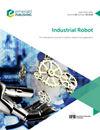Spatial positioning robotic system for autonomous inspection of LPG tanks
IF 2.5
4区 计算机科学
Q3 ENGINEERING, INDUSTRIAL
Industrial Robot-The International Journal of Robotics Research and Application
Pub Date : 2022-06-28
DOI:10.1108/ir-03-2022-0076
引用次数: 1
Abstract
Purpose Automatic robots can improve the efficiency of liquefied petroleum gas (LPG) tank inspection and maintenance, but it is difficult to achieve high-precision spatial positioning and navigation on tank surfaces. The purpose of this paper is to develop a spatial positioning robotic system for tank inspection. The robot can accurately identify and track weld paths. The positioning system can complete robot’s spatial positioning on tank surfaces. Design/methodology/approach A tank inspection robot with curvature-adaptive transmission mechanisms is designed in this study. A weld path recognition method based on deep learning is proposed to accurately identify and extract weld paths. Integrated multiple sensors, the positioning system is developed to improve the robot’s spatial positioning accuracy. Experiments are conducted on a cylindrical tank to test weld seam tracking accuracy and spatial positioning performance of the robotic system. The practicality of the robotic system is then verified in field tests. Findings The robot can accurately identify and track weld seams with a maximum drift angle of 4° and a maximum offset distance of ±30 mm. The positioning system has excellent positioning accuracy and stability. The maximum angle and height errors are 3° and 0.08 m, respectively. Originality/value The positioning system can improve the autonomous performance of inspection robots and solve the problems of weld path recognition and spatial positioning. Application of the robotic system can promote the automatic inspection and maintenance of LPG tanks.用于LPG储罐自主检测的空间定位机器人系统
目的自动化机器人可以提高液化石油气(LPG)储罐检测和维护的效率,但在储罐表面难以实现高精度的空间定位和导航。本文的目的是开发一种用于油罐检测的空间定位机器人系统。该机器人能够准确地识别和跟踪焊接路径。该定位系统可以完成机器人在罐体表面的空间定位。本文设计了一种具有曲率自适应传动机构的油罐检测机器人。为了准确识别和提取焊缝路径,提出了一种基于深度学习的焊缝路径识别方法。为了提高机器人的空间定位精度,开发了集成多个传感器的定位系统。在圆柱形储罐上进行了实验,测试了机器人系统的焊缝跟踪精度和空间定位性能。然后在现场测试中验证了机器人系统的实用性。该机器人可以准确识别和跟踪焊缝,最大漂移角为4°,最大偏移距离为±30 mm。该定位系统具有良好的定位精度和稳定性。最大角度和高度误差分别为3°和0.08 m。该定位系统可以提高检测机器人的自主性能,解决焊缝路径识别和空间定位问题。机器人系统的应用可以促进LPG储罐的自动检测和维护。
本文章由计算机程序翻译,如有差异,请以英文原文为准。
求助全文
约1分钟内获得全文
求助全文
来源期刊
CiteScore
4.50
自引率
16.70%
发文量
86
审稿时长
5.7 months
期刊介绍:
Industrial Robot publishes peer reviewed research articles, technology reviews and specially commissioned case studies. Each issue includes high quality content covering all aspects of robotic technology, and reflecting the most interesting and strategically important research and development activities from around the world.
The journal’s policy of not publishing work that has only been tested in simulation means that only the very best and most practical research articles are included. This ensures that the material that is published has real relevance and value for commercial manufacturing and research organizations. Industrial Robot''s coverage includes, but is not restricted to:
Automatic assembly
Flexible manufacturing
Programming optimisation
Simulation and offline programming
Service robots
Autonomous robots
Swarm intelligence
Humanoid robots
Prosthetics and exoskeletons
Machine intelligence
Military robots
Underwater and aerial robots
Cooperative robots
Flexible grippers and tactile sensing
Robot vision
Teleoperation
Mobile robots
Search and rescue robots
Robot welding
Collision avoidance
Robotic machining
Surgical robots
Call for Papers 2020
AI for Autonomous Unmanned Systems
Agricultural Robot
Brain-Computer Interfaces for Human-Robot Interaction
Cooperative Robots
Robots for Environmental Monitoring
Rehabilitation Robots
Wearable Robotics/Exoskeletons.

 求助内容:
求助内容: 应助结果提醒方式:
应助结果提醒方式:


